Shooting the Sheriff
One of the questions I get asked, as “Why are you going there?” The answer I normally give is simple “because I have never been there before”. In some cases, the journey may well be more of a challenge than others, and reading up about Transnistria on the internet before making a trip to see Sheriff Tiraspol play in the Europa League suggested that this was a foolish choice, and that we were heading to a lawless place where we would be bound to be shaken down by the crooked border guards.
As lawless places go, Tiraspol is a remarkable tidy and ordered city and the officials looking after the border between Transnistria and the rest of Moldova hardly said a word before stamping the small sheet of paper that sits inside the passport to allow a visitor 24 hours in the territory. (The 24 hours is controlled as such my friend Paul was ahead of me in the queue, and was allowed to stay until 11.50 the next day, while I had 5 minutes longer).
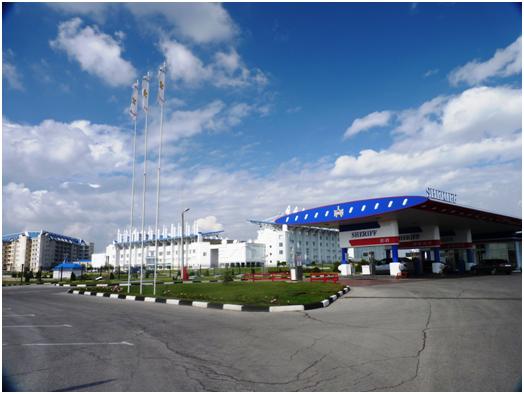
Sheriff Stadium with its own Petrol Station
Once in the city, there is no feeling that there is an overbearing military presence. We walked past a barracks, but saw no other signs of the military. There were not more or less police on the roads than other countries. The people we tried to talk to were friendly and tried to be helpful, although the lack of a common language hindered communications. We had no trouble ordering coffee, food and beer or in buying tickets for the evening game. I will admit we took an easy option over crossing the border by accepting an offer of car and driver for 45 return, we were accompanied by someone who could speak Russian but there were no signs that there would have been difficulties anyway. The ease of crossing surprised a Moldovan Radio Journalist I spoke to in Chisinau. It certainly appears that had we applied to the football club for journalist’s accreditation, they would have passed it on to the border (and this would have caused a problem), while the journalist was surprised that tickets were on sale on the day of the game.
In fact, our biggest problem was obtaining the small programme that was available for the game. This was A5 size, and mainly in Russian (we think). It was distributed (free) somewhere outside the ground, but we did not see them until we were inside. It was therefore down to our blagging skills to obtain this. I can report that both Paul and I ended up with a copy each.
This brings me on to the subject of Transnistria itself. Effectively, the territory is self governing but the only other territories that recognise its independence are those of two other ‘breakaway republics’ from the old Soviet Union. The history, as far as I can work out is that Transnistria was incorporated into the Russian empire sometime in the 18th century. Moldova was part of Romania, and hence in the Austro-Hungarian empire, and then part of Romania until 1940. After 1940, both became the Moldovan Autonomous Soviet Socialist Republic, part of the USSR. It was however one of the quickest to breakaway when the Soviet Union broke up. Under Russian control (autonomy is a name only), the west side of the Dneister river was basically an agricultural economy, while the east bank was heavily industrialised. The population of the west continued to speak Romanian, with Russian as a second language (and for a while, only Cyrillic writing was permitted), but immigration to the east gave a roughly equal split in population between Romanians, Ukrainians and Russians with Russian as the lingua franca. After independence, the Transnistrians did not want to become dominated by a Romanian state, while the Moldovans did not want to lose the heavy industry, and the supplier of 90% of the country’s electricity. There was a bloody conflict from 1990-92 followed by an uneasy peace. The status of Transnistria is basically guaranteed by a Russian army contingent stationed there, but Russia itself shies away from recognising it as a state. There is now relatively free movement across the border, and the majority of the Transnistrian population actually carry Moldovan passports, (they cannot travel without them as the Transnistrian passport is little more than waste paper). Accusations abound about the running of Transnistria, including the influence of Victor Gushan and his Sheriff group, (the country’s second biggest company, after a steel mill that relies on Russian orders). However, most of these accusations come from Moldovan sources, and really need a more thorough examination then they have received. The Sheriff group is the country’s biggest retailer, controlling supermarkets, banks, and petrol stations while the group includes a TV station as well.

Moldova is however, keen to join the EU either on its own or by becoming part of Romania again and this ambition cannot be realised until a solution to the Transnistrian problem is realised. If Moldova agrees to jettison Transnistria, then it is unclear whether it would join the list of mini-states, or if it would itself merge into Ukraine. Just to confuse matters further, another even smaller area of Moldova, Gagauziya (in the south) also would like to break away. Gagauziya has one football team in the Moldovan League promoted last season and now bottom of the top division – and have also entered a team into a non-FIFA board competition in Northern Cyprus. Transnistria has four teams in the Moldovan National Division, with Sheriff having won the title for ten successive years. The other three are FC Tiraspol, Dynamo Bender, and current league leaders Istra-Stal Ribnita (in the north of the country).
From what I can see, the Moldova-Transnistria situation may well be left for some time. It can be resolved in one of two ways. If Moscow were to give up support for the breakaway state, and withdrew its armies, then there would not be little to stop Moldova asserting power but the consequences would probably be bloody, and could well be followed by long running terrorist resistance. The other solution is for the rest of Moldova to decide that joining Europe is more important than keeping all the territory. If Moldova ceded control (in return perhaps for guarantees over electricity, etc), then there would be little in the way of the country joining the E.U or merging with Romania.
Tiraspol is neither a big, nor a spectacular city. It will never be one of the world’s great capitals, but it is functional. It has some wide thoroughfares, often lined with trees and other greenery, it has parks. It has a central church, and unimpressive government buildings. One of these has a fine statue of Lenin outside one of the few reminders of soviet style memorials, and as such an item that should have a preservation order on it.
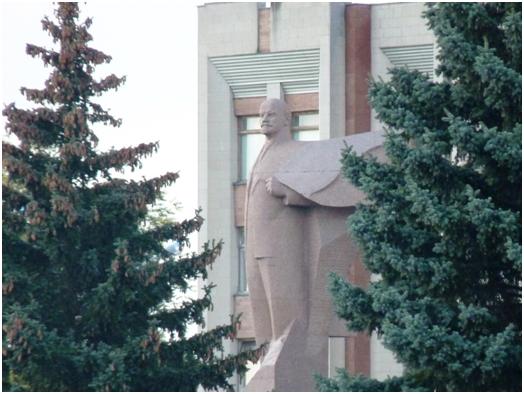
As dusk started to fall, we made our way back to the stadium. We had time for the walk (around 90 minutes) from the centre as UEFA fixed the kick off at 22.05 local time. Although the streets are all lit, in places the main footpath runs the other side of trees, and is in the dark. The footpath is also in places uneven with gaps in the tarmac giving way to mud and puddles. It is no wonder that one of the better selling Sheriff club souvenirs is a torch in club colours.
The stadium complex is on the edge of the town, but can be easily reached by trolleybus or microbus. Cheap taxis would take you there from either the centre of town, or from Bender. Any groundhoppers trying to go to Tiraspol may want to consider that most of their games are later in the day then the rest of the Moldovan League, and between Dynamo Bender and Tiraspol, one does not need a border crossing so a double header is possible when kick offs are three hours apart (at least by taxi).
The stadium is a very modern complex, consisting of two football stadiums a sports hall and an unfinished hotel complex. Both of the stadia have floodlights and stands and would be good enough for league games. It is used by two teams, Sheriff, and FC Tiraspol. The matches never clash, and both tend to late kick offs but there are no signs to show whether any league matches may be played on the smaller stadium. The group photo of the Sheriff team used in the programme did appear to have been taken in the smaller stadium, but this only means that it may well be used as a training venue.
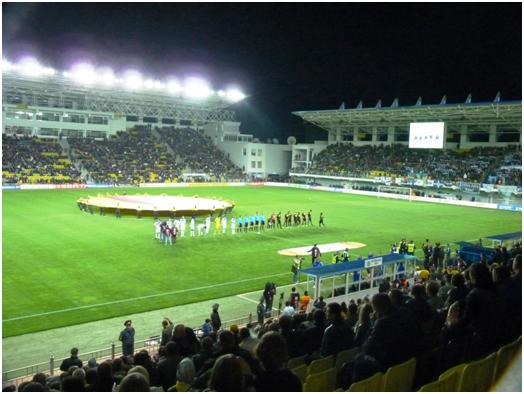
The main stadium is a very functional affair with two near identical sides, and two near identical ends. The roof is at a uniform height all around, and appears as if it would provide protection in poor weather. The end stands are raised above ground level, and have netting between stand and pitch, but this did not stop Kiev fans from lobbing flares onto the pitch, or one fan from actually entering the playing area (from where he was apprehended and taken away). Outside, we met the club mascot, supposedly a bee, (due to club colours of yellow and black). We also met a fan who had come from Odessa, 100 miles or so away (and in the Ukraine). Although he was supporting Kiev, it was not his first time here. Odessa is nearer to Tiraspol than Kiev, so this may be his closest venue with European games. He told us the stadium was around five years old. We also briefly discussed the local politics, and our new friend then translated some comments I made when we were accosted by a roaming TV camera crew. I never found out if they were Transnistrian or Ukrainian, or if they used the footage. My comments were diplomatic, praising the stadium, the friendliness of the people, and promising to support Sheriff, (well, diplomatic assuming it was a local TV crew).
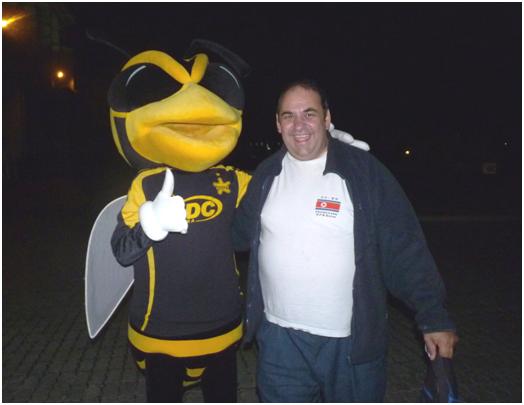
The Sheriff XI on the pitch contained only one local player (and he only gets listed as Moldovan I have been told that he was actually born in Georgia). The other ten starters came two each from Brazil, Serbia and Burundi, one each from Bulgaria, Bosnia, Russia and Senegal. There were three Moldovans on the bench (two of which were from Transnistria), but they (and a Serbian) stayed there. The subs that played came from Latvia, Slovenia and Serbia. By comparison, six of the starting line up for Dynamo Kiev were Ukrainian, supported by a cast from Finland, Croatia, Serbia, Morocco and Nigeria. They left three Brazilians and two Ukrainians on the bench, playing only two subs, from Ukraine and Macedonia.
The game started with Dynamo playing the more assured football, but they fell behind to a freak goal in the 8th minute. The goalkeeper attempted to kick a clearance and the ball hit Erokhin who was as surprised as anyone when the ball looped over the keeper and into the net. Still, for the next half hour, the visitors showed enough to say that they should eventually turn chances into goals, but then as the ball sailed harmlessly over the Kiev area a hand flashed up and helped the ball on its way. Centre half Yevhen Khacheridi was the guilty party, and the penalty meant the score was 2-0 to the home team. The visitors lost heart after this, while the home team rarely looked like adding to the scoreline without actual assistance from the visitors.
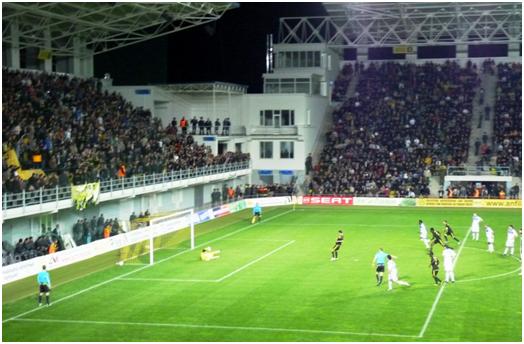
Sheriff Score from the Penalty Spot.
There were sizable contingents from each side determined to sing through the game, with at least 1000 travelling fans in the crowd around 14,000. One third of one end had been fenced off, presumably for tickets sold in Kiev, while the rest of the end seemed to have a majority of blue colours, the yellows of Sheriff gathering at the opposite end. The flares late in the game came from the fenced off section, and if any action is taken, then Sheriff will be criticised for inadequate security, as well as Dynamo as it was their fans. Coming away from the ground, there were queues of traffic in both directions, while two trolleybuses were operating late. Even when we reached the border around 1 in the morning, we had to queue for around 20 minutes a sure sign that a fair portion of the crowd had crossed the Moldova-Transnistria border to see the game. The guards even left the entry paper with our passports (as souvenirs of the visit). This was the only souvenir we found Tiraspol is not known for tourism, and we saw no postcards or other souvenirs at all.

One final point, the match was the first time a Moldovan or Transnistrian had beaten a Ukrainian side, and this was too much for coach Valery Gazzaev. Having seen Kiev miss out on the Champions League for the first time in 5 years, Gazzaev offered his resignation when his team failed to beat BATE (from Belarus) in their first Europa League game. While it was not accepted then, this further failure meant that his tenure at the club had less than 24 hours to run, by the time he left the stadium. Not all the fans agreed that the eclipse of Dynamo as the Ukraine’s leading club is down to Gazzaev, who has previously coached CSKA Moscow to win the UEFA Cup. A poster briefly unfurled in the second half of the game read “We now have nothing left but our memories. Thanks a lot Ihor!” A reference to club chairman Ihor Surkis. Further bad news followed for Kiev when Shaktar beat them three days later to take a five point lead at the top of the league table.